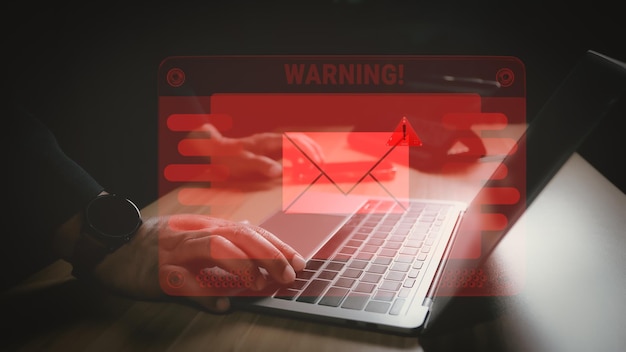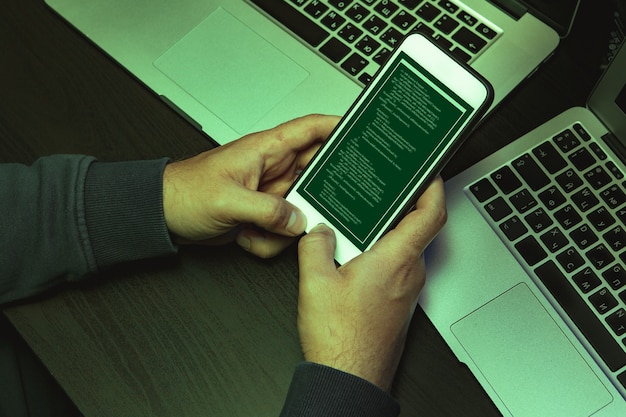Protect Your Email: A US User’s Guide to Phishing Attack Prevention

Protecting your email from phishing attacks is crucial for US users; this guide provides comprehensive strategies to identify, prevent, and respond to phishing attempts, ensuring your personal and financial information remains secure.
In today’s digital landscape, how to protect your email from phishing attacks: a comprehensive guide for US users is more critical than ever. Phishing attacks are becoming increasingly sophisticated, targeting individuals and organizations alike. Understanding and implementing effective security measures is essential to safeguard your personal and professional information.
Understanding Phishing Attacks
Phishing attacks are a type of cybercrime where fraudsters attempt to deceive individuals into revealing sensitive information, such as usernames, passwords, and credit card details. These attacks often involve emails or messages that appear legitimate but are designed to steal your data.
Common Types of Phishing
Phishing attacks come in various forms, each employing different tactics to trick users. Recognizing these types is the first step in protecting yourself.
- Deceptive Phishing: This is the most common type, where attackers impersonate legitimate organizations or individuals to steal credentials.
- Spear Phishing: A more targeted approach, focusing on specific individuals within an organization, using personalized information to increase credibility.
- Whaling: Targeting high-profile individuals, such as CEOs or CFOs, to gain access to sensitive company data.
- Smishing: Phishing attacks conducted via SMS or text messages.
Understanding these different types of phishing allows you to be more vigilant and aware of potential threats. Each type requires a slightly different approach to detection and prevention, emphasizing the importance of staying informed.
In summary, phishing attacks are a serious threat that requires constant vigilance. Recognizing the different types of phishing and understanding the tactics used by attackers is crucial in protecting your email and sensitive information.
Recognizing Phishing Emails
Detecting phishing emails is a crucial skill in protecting your digital security. While attackers are constantly evolving their techniques, certain red flags can help you identify malicious emails.

Key Indicators of Phishing Emails
Being able to spot the signs of a phishing attempt can significantly reduce your risk. Here are some telltale signs to watch out for.
- Suspicious Sender Address: Check the sender’s email address carefully. Phishing emails often come from addresses that are slightly different from the legitimate organization’s domain.
- Poor Grammar and Spelling: Many phishing emails contain grammatical errors and typos. Legitimate organizations typically have professional communication standards.
- Urgent or Threatening Language: Phishing emails often create a sense of urgency, pressuring you to act quickly before you have time to think.
- Requests for Personal Information: Be wary of emails asking for sensitive information like passwords, credit card details, or Social Security numbers. Legitimate organizations rarely request this information via email.
These indicators are not always present in every phishing email, but recognizing them can significantly improve your ability to identify and avoid scams. Remember to always err on the side of caution.
In conclusion, recognizing phishing emails is a critical skill that can protect you from becoming a victim of cybercrime. By paying attention to the sender’s address, grammar, language, and requests for personal information, you can significantly reduce your risk.
Implementing Email Security Measures
Strengthening your email security involves implementing a combination of technical measures and best practices. These steps can significantly reduce your vulnerability to phishing attacks.
Email Security Protocols
Utilizing email security protocols can add layers of protection to your inbox.
- SPF (Sender Policy Framework): This protocol verifies that emails are sent from authorized mail servers, preventing attackers from forging sender addresses.
- DKIM (DomainKeys Identified Mail): DKIM adds a digital signature to outgoing emails, verifying their authenticity and ensuring they haven’t been tampered with during transit.
- DMARC (Domain-based Message Authentication, Reporting & Conformance): DMARC builds upon SPF and DKIM by allowing domain owners to specify how email receivers should handle messages that fail authentication checks.
Enabling Multi-Factor Authentication (MFA)
Multi-Factor Authentication (MFA) adds an extra layer of security by requiring a second form of verification, such as a code sent to your phone, in addition to your password. This makes it much harder for attackers to gain access to your account, even if they have your password.

By implementing these email security measures, you can significantly enhance your protection against phishing attacks and other cyber threats. These steps provide a strong foundation for maintaining a secure email environment.
In summary, implementing robust email security measures is crucial for protecting your data. By utilizing email security protocols like SPF, DKIM, and DMARC, and enabling multi-factor authentication, you can create a more secure email environment.
Using Strong and Unique Passwords
The strength of your passwords is a critical factor in your overall email security. Using strong and unique passwords for each of your accounts can prevent attackers from gaining access, even if one of your passwords is compromised.
Creating Strong Passwords
A strong password should be complex and difficult to guess. Here are some guidelines to follow:
- Length: Aim for at least 12 characters. Longer passwords are generally more secure.
- Complexity: Include a mix of uppercase and lowercase letters, numbers, and symbols.
- Avoid Common Words: Do not use dictionary words, names, or easily guessable information.
The Importance of Unique Passwords
Using the same password for multiple accounts is a significant risk. If one of your accounts is compromised, attackers can use the same password to access your other accounts. Unique passwords for each account minimize this risk.
By following these guidelines, you can create strong and unique passwords that significantly enhance your email security. These practices are essential for protecting your accounts from unauthorized access.
In conclusion, using strong and unique passwords is a fundamental aspect of email security. By creating complex passwords and avoiding the reuse of passwords across multiple accounts, you can significantly reduce your risk of falling victim to phishing attacks.
Regularly Updating Software and Systems
Keeping your software and systems up to date is crucial for maintaining strong email security. Software updates often include security patches that fix vulnerabilities that attackers could exploit.
Why Updates are Important
Software updates are more than just new features; they often include critical security fixes. Ignoring these updates leaves you vulnerable to known exploits.
Regularly updating your operating system, web browser, antivirus software, and other applications is essential. These updates often address security vulnerabilities that attackers could exploit to gain access to your system and email.
By regularly updating your software and systems, you can ensure that you have the latest security protections in place. This helps to minimize your risk of falling victim to phishing attacks and other cyber threats.
In summary, regularly updating your software and systems is a critical step in maintaining strong email security. These updates often include security patches that address known vulnerabilities, helping to protect you from phishing attacks and other cyber threats.
Reporting Phishing Attempts
Reporting phishing attempts is crucial for protecting yourself and others. By reporting these incidents, you can help security organizations track and combat phishing attacks.
How to Report Phishing
Reporting phishing emails is a straightforward process. Here’s how to do it:
Forward the phishing email to [email protected], which is managed by the Anti-Phishing Working Group (APWG). You can also report it to the Federal Trade Commission (FTC) at ftc.gov/complaint. Finally, consider reporting the phishing attempt to your email provider to further protect yourself and other users.
By reporting phishing attempts, you contribute to a safer online environment. Your actions can help prevent others from becoming victims of these scams.
In conclusion, reporting phishing attempts is a vital step in protecting yourself and others. By reporting these incidents to the appropriate organizations, you can help combat phishing and create a safer online environment.
Employee Training and Awareness Programs
For organizations, employee training and awareness programs are essential in preventing phishing attacks. Educated employees are better equipped to recognize and avoid phishing attempts.
Key Components of Training Programs
Effective training programs should cover the following:
- Recognizing Phishing Emails: Training employees to identify the key indicators of phishing emails.
- Safe Email Practices: Teaching employees best practices for handling emails, such as verifying sender addresses and avoiding suspicious links.
- Reporting Procedures: Establishing clear procedures for reporting suspected phishing attempts.
Regular training sessions and simulated phishing exercises can help reinforce these lessons and keep employees vigilant. These programs are a crucial investment in the security of your organization.
In summary, employee training and awareness programs are essential for preventing phishing attacks in organizations. By educating employees on how to recognize and avoid phishing attempts, you can significantly reduce your risk.
| Key Point | Brief Description |
|---|---|
| ⚠️ Recognize Phishing | Spot suspicious emails by checking sender addresses and grammar. |
| 🛡️ Email Security | Use SPF, DKIM, and DMARC to verify email authenticity. |
| 🔑 Strong Passwords | Create long, complex, and unique passwords for each account. |
| 🚨 Report Phishing | Report suspicious emails to [email protected] and FTC. |
Frequently Asked Questions (FAQ)
▼
Phishing is a type of cyberattack where criminals attempt to trick individuals into revealing sensitive information. It’s a threat because it can lead to identity theft, financial loss, and unauthorized access to personal accounts.
▼
Look for suspicious sender addresses, poor grammar, urgent or threatening language, and requests for personal information. Be cautious of emails asking for passwords or credit card details.
▼
Do not click on any links or open any attachments. Report the email to [email protected] and the FTC, and delete it from your inbox.
▼
MFA adds an extra layer of security by requiring a second form of verification, such as a code sent to your phone. This makes it harder for attackers to access your account even if they have your password.
▼
Software updates often include security patches that fix vulnerabilities that attackers could exploit. Regularly updating your software helps protect you from known exploits and cyber threats.
Conclusion
Protecting your email from phishing attacks requires a comprehensive approach. By understanding the tactics used by attackers, implementing security measures, and staying vigilant, US users can significantly reduce their risk. Stay informed, stay secure, and keep your personal and financial information safe.